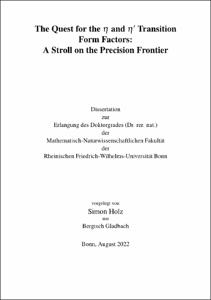Holz, Simon: The Quest for the η and η' Transition Form Factors : A Stroll on the Precision Frontier. - Bonn, 2022. - Dissertation, Rheinische Friedrich-Wilhelms-Universität Bonn.
Online-Ausgabe in bonndoc: https://nbn-resolving.org/urn:nbn:de:hbz:5-67976
Online-Ausgabe in bonndoc: https://nbn-resolving.org/urn:nbn:de:hbz:5-67976
@phdthesis{handle:20.500.11811/10336,
urn: https://nbn-resolving.org/urn:nbn:de:hbz:5-67976,
author = {{Simon Holz}},
title = {The Quest for the η and η' Transition Form Factors : A Stroll on the Precision Frontier},
school = {Rheinische Friedrich-Wilhelms-Universität Bonn},
year = 2022,
month = oct,
note = {An important precision test of the Standard Model of Particle Physics is posed by the prediction of the anomalous magentic moment of the muon. Currently, a deviation of about 4.2σ persists between the experimental average of this quantity and its prediction, the error of which is dominated by hadronic uncertainties. This thesis is aimed at constructing a dispersive data-driven representation of the η and η' transition form factors and subsequently obtaining their pole contributions in the hadronic light-by-light scattering part in the prediction of the muon g-2.
A representation of the singly-virtual η' transition form factor is constructed in the time-like regime. This representation is obtained by a multi-channel formalism dispersively combining data for η'→π+π−γ and the pion vector form factor. Furthermore, it consistently takes the isospin-breaking ρ-ω-mixing effect in both the isovector as well as the isoscalar channel into account.
A step into the doubly-virtual regime of the η transition form factor is taken by analyzing data for the reaction e+e−→π+π-η. It is demonstrated that the a2 tensor meson provides a natural breaking mechanism of the commonly applied factorization ansatz in the doubly-virtual form factor.
The model of factorization breaking through the left-hand-cut contribution of the a2 by crossed-channel effects is further employed in the construction of the η and η' transition form factors starting from the decay η'→2(π+π-). In this decay the a2 left-hand-cut contribution leads to an inhomogeneous Omnès problem, whose solution is numerically challenging. A solution strategy through path deformation in the corresponding dispersion integral is followed. Subsequently, the further application of dispersion relations leads to representations of η(')→γ*γ*.
The pole contributions of pseudoscalar mesons to the hadronic light-by-light scattering part in the muon g-2 are solely determined from the corresponding transition form factors. The general strategy in case of the η and η' mesons is outlined in terms of a simplified form factor model excluding factorization-breaking effects. It is demonstrated that the supplementation of the form factor’s dispersive part by contributions motivated by the fulfillment of the corresponding asymptotic limits leads to a description with quantifiable and controlled sources of uncertainties. The corresponding pole contributions and their uncertainty estimates were extracted by carrying out the g-2 loop integrals. The strategy outlined can also be applied for the full-fledged model including factorization-breaking effects.},
url = {https://hdl.handle.net/20.500.11811/10336}
}
urn: https://nbn-resolving.org/urn:nbn:de:hbz:5-67976,
author = {{Simon Holz}},
title = {The Quest for the η and η' Transition Form Factors : A Stroll on the Precision Frontier},
school = {Rheinische Friedrich-Wilhelms-Universität Bonn},
year = 2022,
month = oct,
note = {An important precision test of the Standard Model of Particle Physics is posed by the prediction of the anomalous magentic moment of the muon. Currently, a deviation of about 4.2σ persists between the experimental average of this quantity and its prediction, the error of which is dominated by hadronic uncertainties. This thesis is aimed at constructing a dispersive data-driven representation of the η and η' transition form factors and subsequently obtaining their pole contributions in the hadronic light-by-light scattering part in the prediction of the muon g-2.
A representation of the singly-virtual η' transition form factor is constructed in the time-like regime. This representation is obtained by a multi-channel formalism dispersively combining data for η'→π+π−γ and the pion vector form factor. Furthermore, it consistently takes the isospin-breaking ρ-ω-mixing effect in both the isovector as well as the isoscalar channel into account.
A step into the doubly-virtual regime of the η transition form factor is taken by analyzing data for the reaction e+e−→π+π-η. It is demonstrated that the a2 tensor meson provides a natural breaking mechanism of the commonly applied factorization ansatz in the doubly-virtual form factor.
The model of factorization breaking through the left-hand-cut contribution of the a2 by crossed-channel effects is further employed in the construction of the η and η' transition form factors starting from the decay η'→2(π+π-). In this decay the a2 left-hand-cut contribution leads to an inhomogeneous Omnès problem, whose solution is numerically challenging. A solution strategy through path deformation in the corresponding dispersion integral is followed. Subsequently, the further application of dispersion relations leads to representations of η(')→γ*γ*.
The pole contributions of pseudoscalar mesons to the hadronic light-by-light scattering part in the muon g-2 are solely determined from the corresponding transition form factors. The general strategy in case of the η and η' mesons is outlined in terms of a simplified form factor model excluding factorization-breaking effects. It is demonstrated that the supplementation of the form factor’s dispersive part by contributions motivated by the fulfillment of the corresponding asymptotic limits leads to a description with quantifiable and controlled sources of uncertainties. The corresponding pole contributions and their uncertainty estimates were extracted by carrying out the g-2 loop integrals. The strategy outlined can also be applied for the full-fledged model including factorization-breaking effects.},
url = {https://hdl.handle.net/20.500.11811/10336}
}






